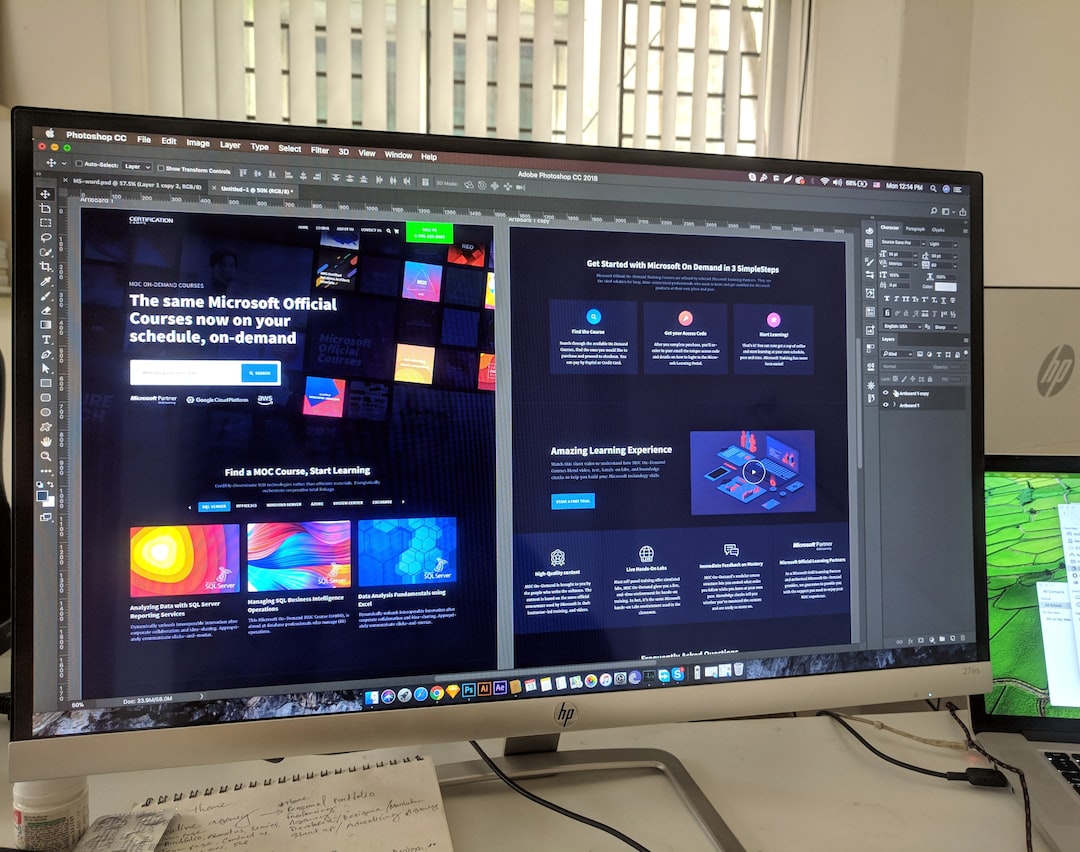When it comes to modern web development and design, two of the most important technologies to understand are HTML and CSS. HTML, or Hypertext Markup Language, provides the backbone of the web by defining the structure and content of a webpage. CSS, or Cascading Style Sheets, acts as the artist’s palette by controlling the presentation and layout of a webpage. Together, HTML and CSS work in harmony to create visually appealing and functional websites that are optimized for the user experience.
Without an understanding of HTML and CSS, it would be impossible to create a website from scratch. HTML provides a framework for organizing content, while CSS provides the look and feel that makes a website stand out from the crowd. Whether you’re building a personal blog, an e-commerce site, or a corporate website, understanding the fundamentals of HTML and CSS is crucial to success in today’s digital landscape.
In this blog post, we’ll explore the ins and outs of HTML and CSS, explaining their respective roles in web development and design. We’ll dive into the key differences between HTML tags and CSS selectors, showcasing real-world examples of how HTML and CSS work together to create stunning websites. By the end of this post, you’ll understand why HTML and CSS are so critical to modern web development and design, and you’ll have a solid foundation for building your own websites. Let’s begin!
HTML: The Backbone of the Web
HTML is the foundation for any website, as it provides the framework for organizing and presenting content on the web. HTML stands for HyperText Markup Language and is the standard language used to create web pages.
Every website is made up of HTML code – it defines the structure of the website, including headings, paragraphs, images, tables and more. HTML allows developers to create different sections on a web page and define their purpose, such as title, content, or navigation links.
HTML is essentially a markup language used to define the structure and syntax of a web page, which is interpreted by web browsers of all kinds to render the visual design of web pages. It’s one of the most basic and essential components of web development, as it is the main language that web browsers use to display web pages.
To create an HTML document, you need to know the syntax and structure of HTML. There are a number of elements that are used within HTML, including but not limited to, tags, attributes, and values. HTML tags are used to define the different sections of a website, such as headings, paragraphs, lists, images, links, and more.
Without HTML, there would be no way to structure the content on a website. HTML provides the foundation that defines the structure of every web page, and it’s impossible to create a website without it. It’s the backbone of the web, and it provides the structure and functionality that makes the web work.
HTML tags are used to define the different sections of a website, such as headings, paragraphs, lists, images, links, and more.
CSS: The Artist’s Palette
CSS, or Cascading Style Sheets, is a language used for describing the look and feel of a website. Unlike HTML, which focuses on the structure and content of a webpage, CSS is all about presentation. With CSS, you can change the colors, fonts, margins, padding, and overall layout of your website.
One of the advantages of using CSS is that it allows you to separate the design elements from the content. By doing so, you can make changes to the presentation of your website without affecting the actual content. This means that you can easily update the look and feel of your website without having to go through each individual page and make changes manually.
CSS works by using selectors to identify specific HTML elements and applying styles to them. Selectors can be based on element type, class, or ID. For example, if you wanted to apply a specific font to all of the headings on your website, you could use the following code:
“`
h1, h2, h3, h4, h5, h6 {
font-family: “Helvetica Neue”, Helvetica, Arial, sans-serif;
}
“`
This CSS code would apply the specified font to all of the heading elements on your website (h1, h2, h3, h4, h5, and h6).
Another powerful feature of CSS is its ability to create responsive designs. With the increasing use of mobile devices to access the web, it’s important that your website is designed to look good on all screen sizes. CSS provides several tools for achieving this, such as media queries and responsive units of measurement (e.g. vw, vh, and em).
In summary, CSS is an essential part of modern website design. It allows you to separate the presentation of your website from the content, and provides powerful tools for styling your site and making it responsive to different screen sizes. Understanding CSS is crucial if you want to create professional-looking websites that are optimized for modern web browsing.
With CSS, you can change the colors, fonts, margins, padding, and overall layout of your website.
HTML Tags vs. CSS Selectors
HTML and CSS are two essential components of web development that work closely together to create beautiful, responsive, and user-friendly websites. HTML provides the structure, while the CSS adds the style and presentation. However, it’s crucial to understand the difference between HTML tags and CSS selectors and how they work together to create cohesive, visually pleasing websites.
HTML tags are the building blocks of a website. They define the different elements of a webpage, such as paragraphs, headers, links, and images. When you create an HTML document, you use tags to wrap the content on your page, providing structure and meaning to your content.
On the other hand, CSS selectors are responsible for styling your HTML elements. They allow you to specify how your content should look, such as color, font, size, and layout. CSS selectors select HTML elements and apply specific CSS properties to them.
Understanding the difference between HTML tags and CSS selectors is crucial to creating consistent, visually appealing websites. HTML tags define the structure of your webpage, while CSS selectors define the style. By using a combination of both, you can create websites that are both visually pleasing and functional.
For example, let’s say you want to create a styling for your webpage’s headers. You would first write your HTML code, which might look something like this:
Welcome to My Website
Learn About Our Services
Contact Us Today
Then, to apply styling to the header text, you would write CSS code that targets the HTML header elements:
header h1 {
font-size: 36px;
color: #333;
text-align: center;
}
header h2 {
font-size: 28px;
color: #666;
text-align: center;
}
header h3 {
font-size: 22px;
color: #999;
text-align: center;
}
By using CSS selectors to target specific HTML elements, you can style them according to your preferences, such as changing the font size, color, and alignment.
In conclusion, understanding the difference between HTML tags and CSS selectors is essential to creating beautiful and functional websites. HTML provides the structure, while CSS adds the style and presentation. By using a combination of both, you can create websites that are both visually pleasing and functional.
HTML Tags vs.
Examples of HTML and CSS in Action
Now that we have talked about the basics of HTML and CSS, it’s time to see how they work together in real-world applications. Let’s take a look at some examples of websites that effectively use these technologies to create beautiful and functional designs.
Example 1: Airbnb’s homepage makes great use of HTML and CSS to create a clean and visually appealing design. The layout is structured with HTML, while CSS is used to style the page elements, such as the font, color, and spacing. The CSS box model is used to arrange the content and images on the page, providing a clear hierarchy of information.
Example 2: The popular blogging platform, WordPress, is built entirely with HTML and CSS. WordPress uses HTML to structure the main content areas, while CSS defines the styles for everything from the typography to the layout of the page. The ability to customize the design with CSS has made WordPress a popular choice for both novice and expert web developers.
Example 3: The online retailer, ASOS, uses HTML and CSS to create an engaging and interactive shopping experience. The product pages are built with HTML, while CSS is used to create animations and hover effects that allow customers to view products from multiple angles. The layout is responsive, meaning it adjusts to different screen sizes, making it easy for customers to shop from their desktop or mobile device.
These are just a few examples of how HTML and CSS work together to create visually appealing and functional websites. In today’s digital age, it’s essential to have a solid understanding of these technologies to create effective web designs. Whether you’re building a personal blog or an e-commerce website, HTML and CSS are the building blocks that will help you create a memorable and successful online presence.
Let’s take a look at some examples of websites that effectively use these technologies to create beautiful and functional designs.
Conclusion: The Importance of Understanding HTML and CSS in Modern Web Development and Design
After examining what HTML and CSS are and their respective roles in website development and design, it should be clear that these two technologies are the backbone of the web. HTML provides the structure and semantic meaning to the content, while CSS is responsible for the visual appeal and style.
In today’s digital landscape, having a strong grasp on HTML and CSS is essential for any web developer and designer. With the ever-expanding online marketplace and the rise of mobile devices, it is critical to create websites that are visually appealing, user-friendly, and accessible across multiple platforms.
Without a solid understanding of HTML and CSS, a website can easily become cluttered, difficult to navigate, or worse – downright unattractive. Additionally, knowing how to properly use HTML and CSS can make a website load faster and improve search engine optimization (SEO) rankings.
We’ve seen how HTML tags and CSS selectors work together to create stunning web pages. When used together effectively, they can make a website stand out from the crowd, enhancing the user experience, and communicating the intended message.
In conclusion, HTML and CSS are the foundation of modern web development and design. No matter what industry you work in or the size of your business, the ability to create beautiful, functional, and user-friendly websites is essential. With a solid understanding of HTML and CSS, you can take your website to the next level and create an engaging online presence that is sure to impress.
In today’s digital landscape, having a strong grasp on HTML and CSS is essential for any web developer and designer.
Further Resources for Learning HTML and CSS
Now that you have a better understanding of HTML and CSS, it’s time to start practicing and experimenting on your own. Luckily, there are a plethora of resources available online to help you continue learning and improving your skills.
One excellent resource is the W3Schools website, which offers interactive tutorials on HTML, CSS, and many other web development technologies. It’s also a great reference guide for commonly used HTML tags and CSS properties.
Another popular option is Codecademy, which offers free and paid courses on web development. They have a specifically tailored HTML and CSS course for beginners that is well-regarded.
If you prefer more in-depth training, Treehouse offers video courses on HTML, CSS, and other web development topics. They also have interactive coding challenges and quizzes to reinforce your learning.
For more advanced users, MDN Web Docs is an invaluable resource for understanding the intricacies of HTML and CSS. It provides detailed documentation on each HTML tag and CSS property, along with examples and best practices.
Finally, don’t underestimate the power of community forums and social media groups for learning and troubleshooting. Websites like Stack Overflow and Reddit have active communities of developers willing to help answer questions and provide feedback on code.
In conclusion, HTML and CSS are essential tools for modern web development and design. By learning the basics and continually seeking out resources for improvement, you can create beautiful and functional websites that stand out in today’s digital landscape.





